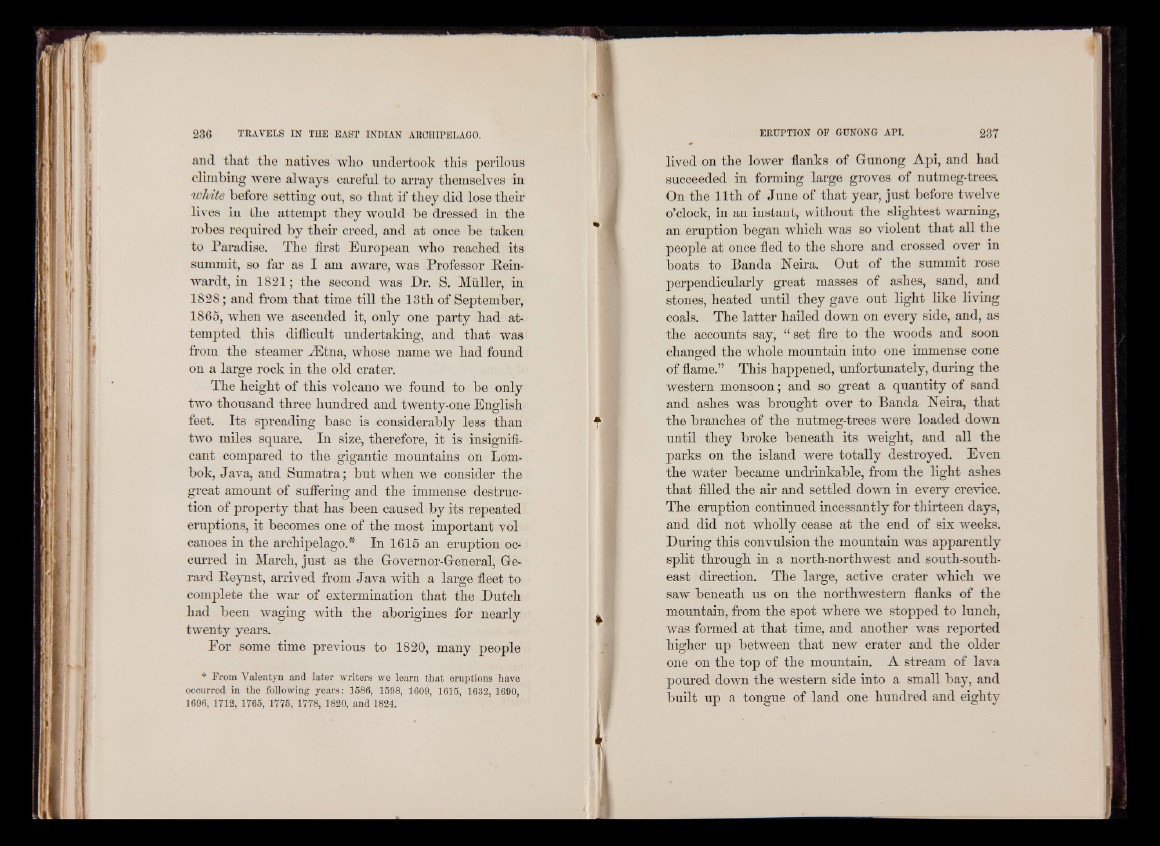
and that the natives who undertook this perilous
climbing were always careful to array themselves in
white before setting out, so that if they did lose their
lives in the attempt they would be dressed in the
robes required by their creed, and at once be taken
to Paradise. The first European who reached its
summit, so far as I am aware, was Professor Rein-
wardt, in 1821; the second was Dr. S. Muller, in
1828; and from that time till the 13th of September,
1865, when we ascended it, only one party had attempted
this difiicult undertaking, and that was
from the steamer JEtna, whose name we had found
on a large rock in the old crater.
The height of this volcano we found to be only
two thousand three hundred and twenty-one English
feet. Its spreading base is considerably less than
two miles square. In size, therefore, it is insignificant
compared to the gigantic mountains on Lombok,
Java, and Sumatra; but when we consider the
great amount of suffering and the immense destruction
of property that has been caused by its repeated
eruptions, it becomes one of the most important vol
canoes in the archipelago.* In 1615 an eruption occurred
in March, just as the Governor-General, Gerard
Reynst, arrived from Java with a large fleet to
complete the war of extermination that the Dutch
had been waging with the aborigines for nearly
twenty years.
For some time previous to 1820, many people
* From Valentyn and later writers we learn that eruptions have
occurred in the following years: 1586, 1598, 1609, 1615, 1682, 1690,
lived on the lower flanks of Gunong Api, and had
succeeded in forming large groves of nutmeg-trees.
On the 11th of June of that year, just before twelve
o’clock, in an instant, without the slightest warning,
an eruption began which was so violent that all the
people at once fled to the shore and crossed over in
boats to Banda Neira. Out of the summit rose
perpendicularly great masses of ashes, sand, and
stones, heated until they gave out light like living
coals. The latter hailed down on every side, and, as
the accounts say, “ set fire to the woods and soon
changed the whole mountain into one immense cone
of flame.” This happened, unfortunately, during the
western monsoon; and so great a quantity of sand
and ashes was brought over to Banda Heira, that
the branches of the nutmeg-trees were loaded down
until they broke beneath its weight, and all the
parks on the island were totally destroyed. Even
the water became undrinkable, from the light ashes
that filled the air and settled down in every crevice.
The eruption continued incessantly for thirteen days,
and did not wholly cease at the end of six weeks.
During this convulsion the mountain was apparently
split through in a north-northwest and south-southeast
direction. The large, active crater which we
saw beneath us on the northwestern flanks of the
mountain, from the spot where we stopped to lunch,
was formed at that time, and another was reported
higher up between that new crater and the older
one on the top of the mountain. A stream of lava
poured down the western side into a small bay, and
built up a tongue of land one hundred and eighty